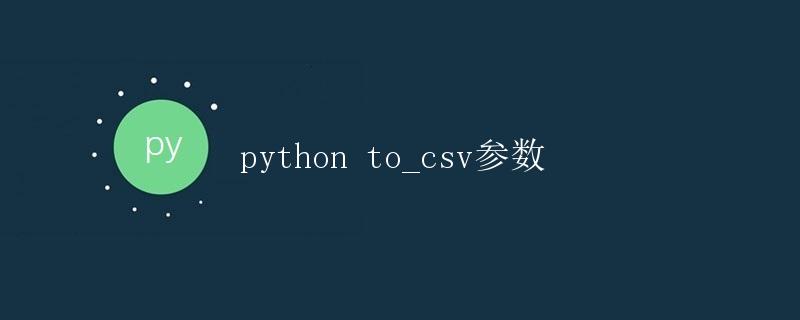Detailed explanation of to_csv parameters in Python
Detailed Explanation of the to_csv Parameters in Python

In Python’s pandas library, we often use the to_csv function to write data to CSV files. The to_csv function provides many parameters for controlling the output format and content. This article will explain the commonly used parameters of the to_csv function in detail to help readers better understand and use it.
to_csv Function Overview
to_csv is a method of the DataFrame object in the pandas library that writes data from a DataFrame to a CSV file. Its basic syntax is:
DataFrame.to_csv(path_or_buf, sep=',', na_rep='', float_format=None, columns=None, header=True, index=True)
Common parameters include:
path_or_buf: Output file path or stream object.sep: Delimiter, defaults to comma.na_rep: String used to replace missing values.float_format: Floating-point format.columns: Output columns.header: Whether to include column names.index: Whether to include row indexes.
We’ll discuss the usage of these parameters in detail below.
path_or_buf
path_or_buf specifies the output file path or stream object. It can be a file name, file object, string, or byte stream. If path_or_buf is a string, the output is sent to a file, for example:
df.to_csv('output.csv')
If path_or_buf is a file object, the output is sent to the file object:
with open('output.csv', 'w') as f:
df.to_csv(f)
sep
sep specifies the delimiter in the output file; the default is a comma. If you want to use a different delimiter, you can set it with the sep parameter. For example, to use a semicolon as the delimiter:
df.to_csv('output.csv', sep=';')
na_rep
na_rep specifies a string to replace missing values with. The default is an empty string. In the output file, missing values will be replaced with the string specified by na_rep. For example, to replace missing values with NULL:
df.to_csv('output.csv', na_rep='NULL')
float_format
float_format specifies the format of floating-point numbers. You can use string formatting syntax, for example, to retain two decimal places:
df.to_csv('output.csv', float_format='%.2f')
columns
columns parameter specifies the output columns. By default, to_csv outputs all columns. You can use the columns parameter to output only specific columns, for example, columns A and B:
df.to_csv('output.csv', columns=['A', 'B'])
header
header specifies whether the output file should include column names. The default value is True. If you don’t want to include column names, you can set header to False:
df.to_csv('output.csv', header=False)
index
index specifies whether the output file should include row indexes. The default is True. If you don’t want to include the row index, set index to False:
df.to_csv('output.csv', index=False)
Sample Code and Results
Below, we’ll use an example to demonstrate the use of common parameters in the to_csv function and output the results:
import pandas as pd
# Create a sample DataFrame
data = {'A': [1, 2, 3], 'B': [4, 5, 6]}
df = pd.DataFrame(data)
# Write the data to a CSV file
df.to_csv('output.csv', sep=';', na_rep='NULL', float_format='%.2f', columns=['A'], header=False, index=False)
# Read the output file contents
with open('output.csv', 'r') as f:
print(f.read())
Running the above code will produce the following output:
1.00
2.00
3.00
In the above example, we created a DataFrame and wrote the data in column A to the file output.csv. Semicolons were used as delimiters, missing values were replaced with NULL, floating-point numbers were formatted to two decimal places, and column names and row indices were not included.
Summary
This article detailed the common parameters of the to_csv function in the Python pandas library, including path_or_buf, sep, na_rep, float_format, columns, header, and index. By flexibly using these parameters, we can better control the format and content of the data output to meet different needs.